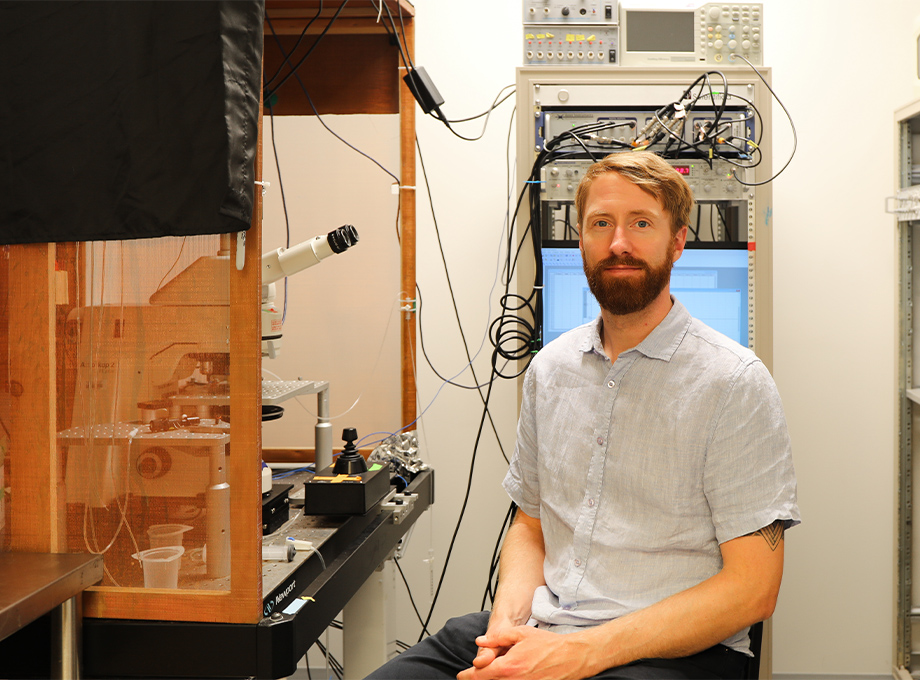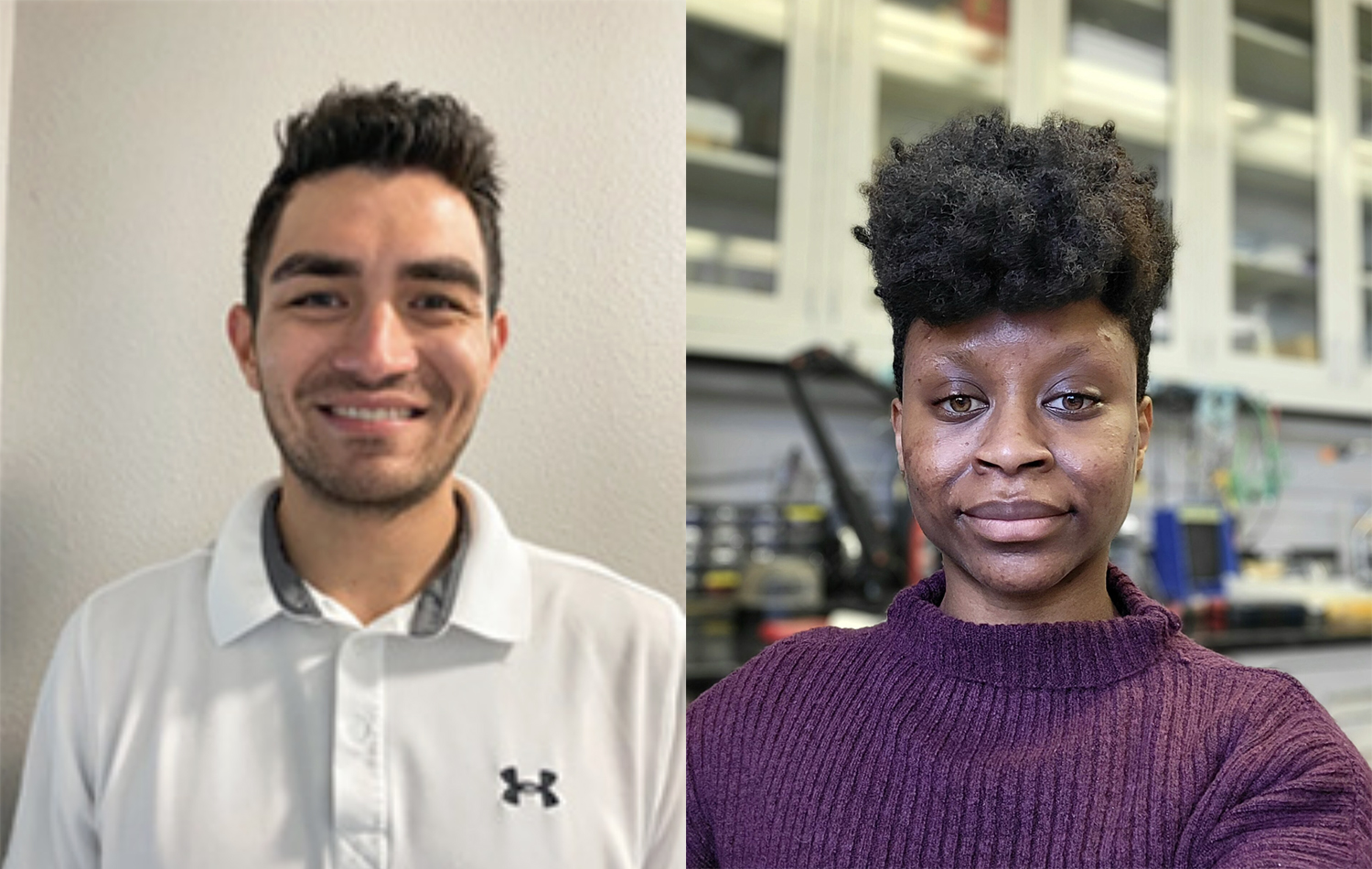Welcome!

The Vollum Institute is a privately endowed research institute at Oregon Health & Science University dedicated to basic research that will lead to new treatments for neurological and psychiatric diseases. Vollum scientists have broad-ranging interests that coalesce around molecular neurobiology and cellular physiology. Their work has transformed the field of neuroscience and, in particular, has provided important advances in the study of synaptic transmission, neuronal development, neurotransmitter transporters, ion channels and the neurobiology of disease.
Learn more about the Vollum's mission
Vollum Seminar Series
Friday Work–In–Progress Talks
The Friday "work-in-progress" (WIP) seminars occur weekly during the academic year and provide an opportunity for postdoctoral fellows and graduate students to share their current research projects in an interactive and less formal environment.
Research highlights
Spatiotemporal calcium dynamics orchestrate oligodendrocyte development and myelination.
Li J, Fiore F, Monk KR, Agarwal A. Trends Neurosci. 2025 Mar 27:S0166-2236(25)00052-9. doi: 10.1016/j.tins.2025.02.010. Online ahead of print. PMID: 40155271 Free article.
Dock1 functions in Schwann cells to regulate development, maintenance, and repair.
Doan RA, Monk KR. J Cell Biol. 2025 May 5;224(5):e202311041. doi: 10.1083/jcb.202311041. Epub 2025 Mar 19. PMID: 40105697 Free PMC article.
Morphological and functional decline of the SNc in a model of progressive parkinsonism.
Muñoz JM, Williams JT, Lebowitz JJ. NPJ Parkinsons Dis. 2025 Jan 29;11(1):24. doi: 10.1038/s41531-025-00873-9. PMID: 39875379 Free PMC article.
Molecular logic for cellular specializations that initiate the auditory parallel processing pathways.
Jing J, Hu M, Ngodup T, Ma Q, Lau SN, Ljungberg MC, McGinley MJ, Trussell LO, Jiang X. Nat Commun. 2025 Jan 9;16(1):489. doi: 10.1038/s41467-024-55257-z. PMID: 39788966 Free PMC article.
Structural insights into subunit-dependent functional regulation in epithelial sodium channels.
Houser A, Baconguis I. Structure. 2025 Feb 6;33(2):349-362.e4. doi: 10.1016/j.str.2024.11.013. Epub 2024 Dec 11. PMID: 39667931.
Astrocyte-dependent local neurite pruning in Beat-Va neurons.
Lehmann KS, Hupp MT, Abalde-Atristain L, Jefferson A, Cheng YC, Sheehan AE, Kang Y, Freeman MR. J Cell Biol. 2025 Jan 6;224(1):e202312043. doi: 10.1083/jcb.202312043. Epub 2024 Dec 9. PMID: 39652106.
Dynamic fibrillar assembly of αB-crystallin induced by perturbation of the conserved NT-IXI motif resolved by cryo-EM.McFarland R, Noroozi R, Miller AP, Reichow SL. Nat Commun. 2024 Nov 28;15(1):10336. doi: 10.1038/s41467-024-54647-7. PMID: 39609421.
Widespread co-release of glutamate and GABA throughout the mouse brain.
Ceballos CC, Ma L, Qin M, Zhong H. Commun Biol. 2024 Nov 13;7(1):1502. doi: 10.1038/s42003-024-07198-y. PMID: 39537846.
PKA regulation of neuronal function requires the dissociation of catalytic subunits from regulatory subunits.
Xiong W, Qin M, Zhong H. Elife. 2024 Nov 7;13:RP93766. doi: 10.7554/eLife.93766. PMID: 39508822.
The Biology of Glia.
Stevens B, Monk KR, Freeman MR. Cold Spring Harb Perspect Biol. 2024 Sep 16:a041809. doi: 10.1101/cshperspect.a041809. PMID: 39284663.
Schwann cell-secreted PGE2 promotes sensory neuron excitability during development.
Kantarci H, Elvira PD, Thottumkara AP, O'Connell EM, Iyer M, Donovan LJ, Dugan MQ, Ambiel N, Granados A, Zeng H, Saw NL, Brosius Lutz A, Sloan SA, Gray EE, Tran KV, Vichare A, Yeh AK, Münch AE, Huber M, Agrawal A, Morri M, Zhong H, Shamloo M, Anderson TA, Tawfik VL, Du Bois J, Zuchero JB. Cell. 2024 Aug 22;187(17):4690-4712.e30. doi: 10.1016/j.cell.2024.07.033. Epub 2024 Aug 13. PMID: 39142281.
Synaptotagmins 3 and 7 mediate the majority of asynchronous release from synapses in the cerebellum and hippocampus.
Weingarten DJ, Shrestha A, Orlin DJ, Le Moing CL, Borchardt LA, Jackman SL. Cell Rep. 2024 Aug 6;43(8):114595. doi: 10.1016/j.celrep.2024.114595. PMID: 39116209.
Structure of the human dopamine transporter and mechanisms of inhibition.
Srivastava DK, Navratna V, Tosh DK, Chinn A, Sk MF, Tajkhorshid E, Jacobson KA, Gouaux E. Nature. 2024 Aug 7. doi: 10.1038/s41586-024-07739-9. PMID: 39112705.
A zebrafish gephyrinb mutant distinguishes synaptic and enzymatic functions of Gephyrin.
Brennan EJ, Monk KR, Li J. Neural Dev. 2024 Jul 27;19(1):14. doi: 10.1186/s13064-024-00191-5. PMID: 39068495.
Precise in vivo RNA base editing with a wobble-enhanced circular CLUSTER guide RNA.
Reautschnig P, Fruhner C, Wahn N, Wiegand CP, Kragness S, Yung JF, Hofacker DT, Fisk J, Eidelman M, Waffenschmidt N, Feige M, Pfeiffer LS, Schulz AE, Füll Y, Levanon EY, Mandel G, Stafforst T. Nat Biotechnol. 2024 Jul 12. doi: 10.1038/s41587-024-02313-0. PMID: 38997581.
Optical Control of TRPV1 Channels In Vitro with Tethered Photopharmacology.
Howe CL, Icka-Araki D, Viray AEG, Garza S, Frank JA. ACS Chem Biol. 2024 Jul 19;19(7):1466-1473. doi: 10.1021/acschembio.4c00052. Epub 2024 Jun 21. PMID: 38904446.
OHSU honors Eric Gouaux, Ph.D. at investiture ceremony

Congratulations to the Vollum’s Eric Gouaux, Ph.D. who was honored recently at an OHSU investiture ceremony. The October 2024 ceremony celebrated Eric’s award as the Jennifer and Bernard Lacroute Term Chair.
US House Representative Suzanne Bonamici visits the Vollum Institute

The Vollum hosted US Rep Suzanne Bonamici, from Oregon’s 1st District, recently to discuss the Vollum and neuroscience at OHSU (Oct 31st), particularly work in neurological disease.
We thank US Rep Bonamici for taking time out of her schedule with an in-person visit to learn about the Vollum’s research and for her continued strong support for basic biomedical research and the NIH.
Prestigious award seeks to advance new avenue of addiction treatment

A chemical biologist at Oregon Health & Science University has become just the second researcher in the institution’s history to receive a prestigious Avenir Award from the National Institute on Drug Abuse, known as NIDA, of the National Institutes of Health.
James Frank, Ph.D., assistant professor of chemical physiology and biochemistry in the OHSU School of Medicine and the Vollum Institute at OHSU, will use the award to develop new tools to improve understanding of an alternative suite of receptors in the brain believed to be involved in opioid addiction.
Two graduate students named 2024 Lacroute Fellows

Two predoctoral students in the Neuroscience Graduate Program at OHSU were recently awarded the 2024 Lacroute Fellowship.
The Lacroute Fellows Program supports exceptional graduate students conducting innovative research in the Vollum Institute/OHSU Neuroscience Graduate Program. The one-year fellowships cover $24,000 of the students’ stipend and provide a $1,000 allowance for related academic expenses, such as attending scientific conferences or courses.
Congratulations to the 2024 fellows:
- Adam Coombs, Emery Lab and Monk Lab
- Michéla Mondesir, Cochlear Implant and Hearing Aid Research Lab and Laboratory of Brain, Hearing, and Behavior
More news and accolades
Recognition for our early career awardees
Graduate students and postdoctoral fellows are usually supported by research grants to individual faculty or by institutional training grants from the NIH. However, a sought-after perk for trainees is to obtain an individual fellowship from federal sources or foundations. Such awards are an honor and also provide important financial support for the trainee and their lab. Graduate students and postdoctoral fellows in the Vollum Institute have been remarkably successful in obtaining these awards over the past few years. This is a credit to the quality of the trainees and the support they receive from their mentors. Congratulations to all.
The Lacroute Fellows Program invests in School of Medicine graduate education, by supporting exceptional students performing innovative research in the Vollum/OHSU Neuroscience Graduate Program.
- Adam Coombs, Emery Lab and Monk Lab
- Michéla Mondesir, Cochlear Implant and Hearing Aid Research Lab and Laboratory of Brain, Hearing, and Behavior
These 1-year fellowships cover $24,000 of the student’s stipend and provide an allowance of $1,000 for related expenses, such as attending scientific conferences or courses.
Read the full article.
Cody Call, Ph.D., Monk Lab
NINDS F32: “Regulation of node of Ranvier formation and maintenance by astrocytes.”
Alejandra Fernandez, Ph.D., Wright Lab
Collins Medical Trust: “The role of Pten signaling in the intrinsic control of somatosensory neuron diversification.”
Kevin Guttenplan, Ph.D., Freeman Lab
Helen Hay Whitney Foundation: “How do astrocytes regulate neuronal circuits?”
Dongeun Heo, Ph.D., Monk/Freeman Labs
NINDS F32: "Investigating the role of diazepam binding inhibitor (DBI) in astrocytes and neural circuit maturation."
Taylor Jay, Ph.D., Freeman Lab
NINDS K99/ROO: "Investigating novel mechanisms that underlie glial-mediated synapse elimination in development and aging."
Yunsik Kang, Ph.D., Freeman Lab
NINDS K99/ROO Pathway to Independence: “How do astrocytes remodel neuronal circuits?”
Alex Nevue, Ph.D., Saunders Lab
BRAIN Initiative/NINDS F32: "Postnatal experience shapes gene expression and connectivity development in the cortex."
Cathy Spangler, Ph.D., Gouaux Lab
NIH Natl Cancer Inst: “Structural and functional characterization of native AMPA receptor complexes in glioblastoma.”
Dennis Weingarten, Ph.D., Jackman Lab
Grass Fellowship at MBL: "Sour patch: Electrophysiological study of synaptic transmission during hypercapnia in the lamprey.”
Landon Bayless-Edwards, Mao Lab
NIDA NRSA F30: "Intracellular signaling mechanisms underlying opioid modulation of pain"
Hannah Collins, Monk and Emery Labs
NINDS F31: “Control of CNS Myelination by the E3 Ligase Component Fbxw7”
Arielle Isakharov, Wright Lab
NEI F31 Predoctoral Fellowship: "Genetic analysis of the Robo3+ glycinergic amacrine cell"
Jennifer Jenks, Emery Lab
National Science Foundation, Graduate Research Fellowship
Tania Miramontes, Monk Lab
NINDS F31: "Investigating the role of cannabinoid receptors in oligodendrocyte development"
Melanie Piller, Monk Lab
NINDS F31: "The role of P/Q-type channels in oligodendrocyte lineage cell development"
Yessica Santana Agreda, Wright Lab
HHMI Gilliam Fellow: "Transcriptional Control of Starburst Amacrine Cell Specification and Maturation"
Erin Santos, Freeman Lab
HHMI Gilliam Fellow: "CamKII-Dependent Mechanisms of Astrocyte Ca2+ Signaling"
Frederika Sullivan, Wright Lab
National Science Foundation, Graduate Research Fellowship
Congratulations to all of our graduate researchers in the Vollum/OHSU Neuroscience Graduate Program who received ARCS Foundation Scholar Awards from the ARCS Oregon Chapter!
First Year: Milana Krush and Jed Syrenne
Second Year: Teva Bracha and Kim Engeln
Third Year: Sweta Adhikary, Amelia Culp, Makayla Freitas and Sierra Smith
Learn more about these scholars and the ARCS Foundation Oregon
Congratulations to the Neuroscience Graduate Program researchers — Ali Pincus, Prashant Rao and Petra Richer — who received 2020 N.L. Tartar Trust Fellowships. The $2,000 grants are awarded annually by the OHSU School of Medicine as a means to support research endeavors and career development. Keep up the great work!